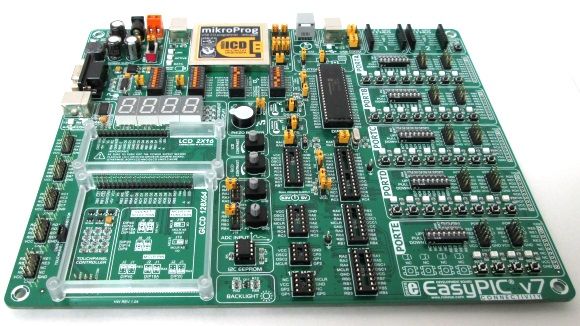Unpacking EasyPIC v7
EasyPIC v7 comes in a colorful and protective cardboard box that can also serve as a good storage for the development board for later use. The thing I liked most about it is that the box also contains color-printed schematics and illustrative user’s manual of EasyPIC v7 along with a DVD for installing the required drivers and programming applications. The DVD also contains demo versions of mikroElektronika’s compilers as well as plenty of code examples. The EasyPIC v7 board is packed inside an anti-static bag and an USB cable is also included in the package to connect the board to the PC.
– See more at: http://embedded-lab.com/blog/?p=8351#sthash.bJ3OVTRs.dpuf
Main Features Highlight
EasyPIC v7, like its predecessors, is designed for rapid prototyping and development with Microchip’s 8-bit microcontrollers. It supports over 350 PIC microcontrollers, including PIC10F, PIC12F, PIC16F, and PIC18F series, and contains 8 DIP sockets to accommodate 8-, 14-, 18-, 20-, 28-, and 40-pin count PIC MCUs. The printed circuit board of EasyPIC v7 is extra thick (~3mm) and of high quality with clearly labeled components and pin functions. The board comes with the PIC18F45K22 microcontroller plugged in by default. Here I have summarized the main features of the EasyPIC v7 development board.
– See more at: http://embedded-lab.com/blog/?p=8351#sthash.bJ3OVTRs.dpuf
Power supply
EasyPIC v7 has a 5.0V switching power supply on board along with a 3.3V regulated output. A jumper selection is provided to select between 3.3V and 5.0V power supply for operation. Thus, it can be used to develop applications for both 3.3V and 5.0V series PIC MCUs. The board can be powered through a DC barrel jack, screw terminal block, or directly through an USB cable.
– See more at: http://embedded-lab.com/blog/?p=8351#sthash.bJ3OVTRs.dpuf

